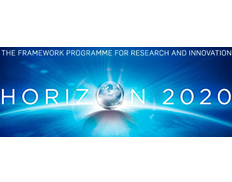Share
Print

11 August 2017 15:55
An overview of the evaluation results (called 'Flash Call Info') of the topics of the H2020-ICT_2017-1 call is now available under the section Topic conditions and documents - additional documents.
28 April 2017 12:46
The submission of proposals to the 18 topics of this H2020-ICT-2017 call closed on 25 April 2017. A total of 995 proposals were submitted in response to these topics. Please find below the breakdown for this topic and type of action: Topic ICT-31-2017
(RIA)- 43;
(IA)-6;
(CSA)-1;
TOTAL -50
16 January 2017 16:25
As of 1st January 2017, Switzerland is associated to the entire H2020 programme. In consequence, it is now also associated to this topic. In a nutshell this means that Swiss partners in a proposal are now on an equal footing with partners from EU Member States or other Associated Countries. For the details, please read this note.
08 December 2016 00:30
The submission session is now available for: ICT-31-2017(IA), ICT-31-2017(CSA), ICT-31-2017(RIA)
TOPIC : Micro- and nanoelectronics technologies
| Topic identifier: | ICT-31-2017 | ||
| Publication date: | 14 October 2015 | ||
| Types of action: | CSA Coordination and support action,RIA Research and Innovation action,IA Innovation action |
||
| DeadlineModel: Planned opening date: |
single-stage 08 December 2016 |
Deadline: | 25 April 2017 17:00:00 |
| Time Zone : (Brussels time) | |||
| Topic | Budget (EUR) - Year : 2016 | Budget (EUR) - Year : 2017 | Stages | Opening date | Deadline | |||
|---|---|---|---|---|---|---|---|---|
| ICT-31-2017 - CSA Coordination and support action | 1,000,000 | single-stage | 08 December 2016 | 25 April 2017 | ||||
| ICT-31-2017 - RIA Research and Innovation action | 19,000,000 | single-stage | 08 December 2016 | 25 April 2017 | ||||
| ICT-31-2017 - IA Innovation action | 3,000,000 | single-stage | 08 December 2016 | 25 April 2017 | ||||
Horizon 2020
While the state-of-the-art micro/nano-electronics technologies and their manufacturing are being further advanced towards market-readiness in the context of the ECSEL Joint Undertaking, it is essential to prepare for the future of the electronics industry the next wave of industry-relevant technologies to extend the limits (technological and/or economic) mainstream technologies will be facing in the medium term[1]. This is essential to maintain and increase Europe's longer-term capacity in the design and manufacturing of these technologies and to strengthen the competitiveness and market leadership of the many industries innovating through these technologies.
Scope:a. Research and Innovation actions
The work must be in the scope of one of the following topics:
International cooperation with clear EU industrial benefits may be considered preferably with nations that have substantial research in the area (e.g. Japan, South Korea, Taiwan, and the USA).
The Commission considers that proposals requesting a contribution from the EU of between EUR 2 and 4 million would allow this specific challenge to be addressed appropriately. Nonetheless, this does not preclude submission and selection of proposals requesting other amounts.
b. Innovation action[2]
In Equipment Assessment Experiments, suppliers of innovative high-tech equipment install, assess and validate their prototypes or products that have left the R&D phase in environments that are very close to real-life conditions in cooperation with end-user. Proposals at TRL 6-7 are called for.
The Commission considers that proposals requesting a contribution from the EU between EUR 1 and 2 million would allow this specific challenge to be addressed appropriately. Nonetheless, this does not preclude submission and selection of proposals requesting other amounts.
c. Coordination and Support actions
In view of promoting the attractiveness of careers in micro/nanoelectronics towards young people, a dedicated pan-European challenge event should be proposed to showcase the possibilities offered by state-of-the-art hardware technologies (similar to the European code week for software apps). The sustainability of this event should also be addressed.
The Commission considers that proposals requesting a contribution from the EU of about EUR 0.5 million would allow this specific challenge to be addressed appropriately. Nonetheless, this does not preclude submission and selection of proposals requesting other amounts.
Expected Impact:Proposals should address the following impact criteria and provide metrics to measure and monitor success
a. Research and Innovation actions
The actions will aim at contributing to the future growth in Europe of the micro-/nanoelectronics and related industries.
b. Innovation actions
c. Coordination and Support actions
[1]Graphene is covered by the eponym FET Flagship initiative
[2]Access actions (including EuroPractice-type actions) are addressed under ICT-4
[3]https://ec.europa.eu/digital-agenda/en/electronics-roadmap-europe
[4]https://ec.europa.eu/digital-agenda/en/news/european-industrial-strategic-roadmap-micro-and-nano-electronic-components-and-systems-0
